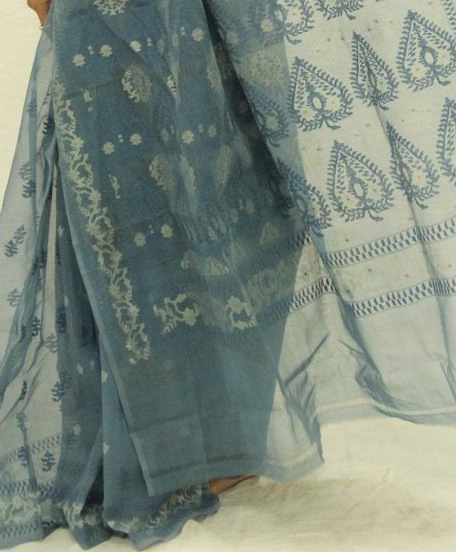Jamdani Cotton Sari
Background
It is believed that the word ‘Jamdani’ derived from Persian word ‘Jama’ meaning cloth and ‘Dana’ meaning buti or diapering. Jamdani weaving flourished under Mughal Emperors who appreciated the excellence of this Jamdani weaving.

Jamdani is a fine cloth figured with geometric or floral designs. Due to this superfine cloth, handloom weaving had become a fine art in 15th and 16th century. Later in 17th century, this Jamdani fabric was also used for dresses. Presently, Jamdani fabrics are produced in weavers concentrated areas of Burdwan, Nadia districts in West Bengal on frame looms.
Material used
Traditional jamdani fabrics are produced using 100s, 120s and above count of cotton yarns for warp and weft while 4 to 6 ply cotton yarn used for extra weft either in white or dyed . Later they started using Zari also. Now a days jamdani sarees and dress materials are woven with cotton yarn of count ranges from 60s to 100 , using steel reeds of 68 – 72s count.
Weaving Technique
Jamdani is a weaving technique of figured cotton textiles, in transparent plain ground, with designs of extra weft. Design motifs are directly woven by weavers from their memory without the help of any design device. They adapted a traditional and indigenous technique which involves ‘throw shuttle’ (presently fly shuttle is used) and extra weft insertion by needle. Jamdhani motifs are known by different names viz. ‘panna’, ‘hajar’, ‘dubli’, ‘jal’, ‘butidar’, ‘tersa’, ‘charkona’ ,’fulwar’, ‘duria’,’belwari’ etc. depending upon the arrangements . Motifs of Jamdani fabrics are mainly of geometrical and floral concepts adopted from local environment like flowers, leaves, mango, zig-zag lines etc. Also, it covers ‘Hazzar buti (One thousand) , Tagar ful, Bokul ful , Dorakata, Mala etc. The special design pattern of paisley motif in the corners of palloo portion, locally known as ‘konia’ is produced by skilled Jamdani weavers.
How to distinguish genuine Jamdani Saree
- Jamdani fabrics can easily be distinguished by seeing the extra weft which is usually inserted in the ratio of two ground thread and one design thread.
- Bulging effect is seen at the design portions of the fabric since design thread is coarser than ground thread.
- The extra un-cut weft is interlaced with warp threads to form the design from left to right and vice versa in such a way that it cannot be pulled off.
- Turning of design thread from left to right and vice versa is clearly seen in the back side of the fabric.
Source : India Handloom Brand
Last Modified : 9/5/2023
This topic provides information about Banarasi But...
This topic provides information about Uppada Jamda...
This topic provides information about Cotton pattu...
